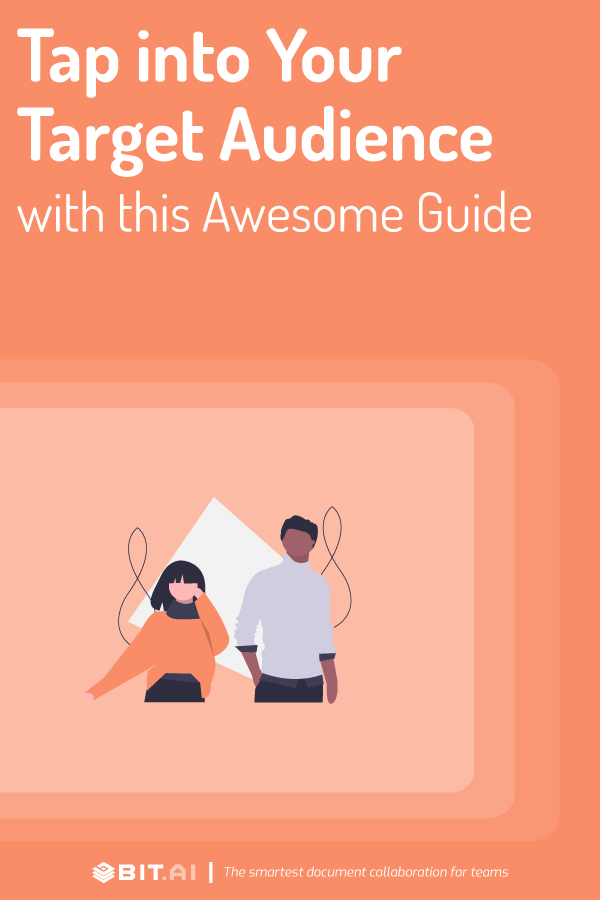Every business comes with great risk.
For your business to succeed and move past the risks, you need to understand the audience that you’re serving.
If you don’t speak to the right audience, your brand message will simply get lost in all the noise.
Let’s say you are a makeup brand. One of the best places for you to advertise would be in a beauty and lifestyle magazine rather than a normal newspaper, right?
This way, you hit the specific audience that is already interested in what you have to offer. You go from throwing darts in the dark to a foolproof plan that is sure to hit!
In this blog, we’ll tell you all about why identifying your target audience is important and how you can find them.
But, before all that, let’s get to the basics!
What is a Target Audience? (Definition)
The word target audience is tossed around a lot! But do you know what it exactly means?
Let us help you out!
A target audience can be defined as a demographic of people who would most likely be interested in your company’s product or service.
Simply put, they’re the prospective customers that a company wishes to acquire or customers who are most likely to purchase your product or service.
Target audiences can be governed by many similar factors including, but not limited to, age, gender, location, income, and more.

Let’s consider a target audience for a brand selling low-cost, organic protein bars. In such a case, the target audience would be:
- Age – 18-35
- Gender – Male & Female
- Other factors: Someone who is health-conscious, follows health gurus, has a limited food budget for supplements, etc.
The identification of the target audience brings about a slew of advantages for your firm. It helps you to categorize who you are catering to, how your firm can approach them and what marketing strategies will work to get you there.
It’ll also help you create customized and personal campaigns that strike a chord with the audience who are most likely to buy your product.
For example: In 2017, when Pandora, a jewelry store, wanted to expand their reach to German audiences, and target couples between the age group of 20 to 50, they ran an ad campaign on Facebook (popular among adults) showing a woman receiving a Pandora necklace from her partner.
The ad did its intended job so well that it led to a 61% lift in purchases and a 42% increase in new buyers.
This is exactly how target audiences when addressed to, in the right manner, can help scale a business to great extents.
Let’s talk more about why finding your target audience is of importance!
Read more: 9 Customer Acquisition Strategies Your Boss Wishes You Knew!
Importance Of Finding Target Audiences
Finding target audiences may require adequate research and some tweaks but once determined, it’ll make your business processes much easier and more focused!
As soon as target audiences are identified, a business can advertise in a much efficient manner. They can center the needs of the target audiences and directly advertise to potential customers to grab their attention.

As per a Salesforce survey, 76% of consumers expect companies to understand their needs and expectations!
Yes, you’ve heard the verdict from the people now.
That is exactly why finding your target audience is vital because they want businesses to find them and address them directly.
Some other reasons why one needs to find their target audience:
1. When you market to your target audience, there is more probability that it’ll derive an action from them that would have rather gone unnoticed if it went to the wrong person.
For example: If you are someone who loves fashion, you are more likely to visit a clothing website that appeared on your socials than some product that you are not interested in.
2. When you know better, you do better! Now that you know your audience, you can speak to them in a better way. Such marketing will help strike a chord with like-minded people and thus generate sales.
3. Failing to identify your target audience will not only lose you coveted sales, it’ll cost you time and also lead to wasted efforts and money.
All in all, identifying target audiences help you attract the right people for your business. You don’t only drive traffic to your site, you drive revenue.
Not just that, you gain a competitive edge and all of your efforts are much more centered.
So now, the big question arises, how do you find your target audience? Let’s jump straight in…
Steps To Find Your Target Audience
It’s wisely said that even when you’re planning for an entire audience, you are only speaking to one single person at a time. That sums up why you need to find the right target audience.
There is no one universal way to find them, but some steps surely do work better than others.
1. Understand What Your Brand Offers
Before you start understanding your audience, it’s crucial to understand your brand better.
Think of its benefits and not features. Think of your brand as a solution.
Now, whose problem are you addressing with this solution?
When you do this, you’ll get to know what interests and needs you are serving.
Now, try to decide who would benefit the most when these needs are addressed?

And last but not the least, why is your brand better than the others?
These questions will help you lay a base for a more comprehensive way to find your target audience.
2. Analyzing Competition
It’s always good to take a look at your competitors and who they consider their target audience.
Understanding their marketing efforts will help you learn for free. Check what platforms they are most active on, where they receive their most engagement and how they advertise.
Studying their moves will help you perfect yours!
But do not create a carbon copy of their work as they might possibly not serve the same audience as you.
Analyzing such competition won’t help you find the answers directly, but it’ll surely give you some perspective on what marketing tactics work for them or and what doesn’t.
3. Use Google Analytics
Google Analytics is a highly functional tool that can help in multiple areas when deciphering your target audience.
They provide comprehensible and concise graphs and analytical data as an overview of all the traffic that is generated on your website.
From gaining demographic data to understanding the interests of the audiences already visiting your website, it has you covered from top to bottom!
You can use all this data to map similarities and construct an idea about your target audience.
Google Analytics acts as an asset that lets you in on necessary and vital insights that could help shape the perfect target audience.
Let’s say if the majority of the audience coming to your site is new mothers in their mid-20s. You can create a distinct marketing plan that serves to attract them specifically!
Read more: Best Customer Analytics Tools and Software in 2021
4. Sending Out Customer Surveys
Before moving on to the next step, you must send out customer surveys and understand your consumer base a bit better. You can use the data received from Google Analytics to find your demographic data.
The purpose of this is to combine this new data with your already existing analytics and identify trends and similarities.
For example: If you own a SaaS company, you can get information about your new customers while they are signing up. You can ask them about their age, profession, etc. This way, you can collect useful data about your target audience easily and save up time by indirectly conducting surveys right from the start.
This data will help you get started with the next step!
5. Creating Personas
One of the most exciting and pivotal parts of finding your audience is creating personas.
Personas are fictional or made-up characters that are created by a firm based on their research about their audiences. This helps to monitor consumer needs, behaviors, and more.
They are created based on data, surveys, or any other piece of information about your customer that you’ve collected or generated via systems.

Crafting a lifelike persona will go a long way in identifying the right target audience.
Some key points to include in your persona are name, image, the background of the persona, their goals, aspirations, motivations, etc.
It is suggested that a firm create at least three to five personas to gain a complete and concise image of the type of target audience they need to cater to.
6. More and More Research
It’s an ever-changing world and thus, your research will definitely need updates and revisions.
The more the research, the more likely you are to find the most accurate target audience for your brand.
In the same way, with every new research, the personas have to be updated and customized accordingly.
Research like this can sometimes get tedious but with the help of the right tools, this process can get a lot better!
And for that, we suggest you try out this wonderful tool known as Bit.ai that incorporates all facets of modern-day research under one roof. Bit allows you and your teams to collaborate, share, track, and manage all knowledge and research in one place.
7. Start Building a Community
Now with all this data, you know almost everything you need to know about your target audience.
Now, you need to use this data to your advantage, build a community and connect with the audience that needs your product or service.
You can use social media to bring all these like-minded people together. Interact with them and create a longstanding brand connection with them!
Over To You
Today’s user is no longer uninformed or passive. He knows how to interact and only wants what falls under the umbrella of his needs.
This makes finding your target audience more important than ever.
Identifying your audience will help you shape your brand message and marketing strategy in the most efficient manner possible.
Without knowing your audience, you’ll find your business in deep water.
So, don’t pull audiences out of a hat. Instead, make sure you devise a plan. Follow the steps given above and research as much as you can.
Keep in mind: It’s always better to have a small group that cares than a large one that doesn’t!
Our job here is done, but now it’s time for you to get started!
Got any queries? Tweet us @bit_docs and let us know! We’d be happy to hear from you!
Further read:
10+ Powerful Sales Tips Every Sales Rep Should Know!
Social Proof: 8 Ways to Use it to Get More Sales!
Value Proposition: What is it & How to Write it?
11 Amazing Sales Promotion Examples You Need to Check Out!
Marketing Campaign Plan: What is it & How to Create it?
Marketing Communication Strategy: What is it & How to Create it?

Related posts
Bit.ai | Watch to Learn More
What is Bit.ai?
Bit.ai is an innovative AI-driven knowledge and Document Managment suite designed to empower knowledge workers by streamlining the creation of, documents, wikis, and notes. With an intuitive interface and seamless integration, Bit.ai acts as a versatile assistant to help you collaborate, generate, organize, and visualize your ideas effortlessly. Whether you are drafting a report, managing a project, collaborating with your team or clients, or brainstorming new concepts, Bit.ai brings intelligence and creativity to every aspect of your work process.



